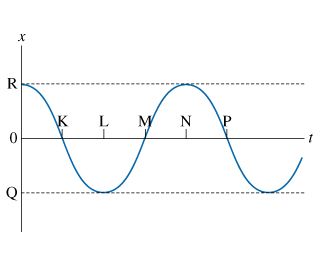
College Physics
11th Edition
ISBN: 9781305952300
Author: Raymond A. Serway, Chris Vuille
Publisher: Cengage Learning
expand_more
expand_more
format_list_bulleted
Concept explainers
Topic Video
Question
thumb_up100%
Assume the x coordinate of point R is 0.12 m and the t coordinate of point K is 0.0050 s.
What is the period T? Express your answer in seconds.
How much time t does the block take to travel from the point of maximum displacement to the opposite point of maximum displacement? Express your answer in seconds.
What distance d does the object cover during one period of oscillation?What distance d does the object cover between the moments labeled K and N on the graph?
Express your answer in meters.

Transcribed Image Text:X
R
0
بعد
Q
K L M N P
t
Expert Solution
This question has been solved!
Explore an expertly crafted, step-by-step solution for a thorough understanding of key concepts.
This is a popular solution
Trending nowThis is a popular solution!
Step by stepSolved in 3 steps with 1 images

Knowledge Booster
Learn more about
Need a deep-dive on the concept behind this application? Look no further. Learn more about this topic, physics and related others by exploring similar questions and additional content below.Similar questions
- Part A (Figure 1) shows velocity graph for an oscillation along the x-axis. What is the maximum speed of the oscillation? Express your answer to two significant figures and include the appropriate units. HÁ Value Units Umax = Submit Request Answer Figure K 1 of 1> Part B V, (cm/s) What is the frequency of the ocillation? 60 Express your answer to two significant figures and include the appropriate units. 30 µẢ t (s) 12 6. 6. -30 f = Value Units -60- Submit Request Answer 3.arrow_forwardquestion d and e please For any vector quantity, be sure to always include the magnitude and direction(teacher asked)arrow_forwardA 2.00 kg, frictionless block s attached to an ideal spring with force constant 350 N/m. At t = 0 the spring is neither stretched nor compressed and the block is moving in the negative direction at 11.0 m/s. Show Transcribed Text Part A G Find the amplitude. Express your answer to three significant figures and include the appropriate units. Show Transcribed Text Part B Go Find the phase angle. Express your answer in radians. Show Transcribed Textarrow_forward
- The analysis of a simple pendulum assumed that the mass was a particle, with no size. A realistic pendulum is a small, uniform sphere of mass M and radius R at the end of a massless string, with I being the distance from the pivot to the center of the sphere. Part A Find an expression for the period of this pendulum. Express your answer in terms of the variables M, R, L, and free fall acceleration g. T= IVE ΑΣΦ Submit Part B Request Answer Suppose M = 25 g, R = 1.0 cm, and L = 1.0 m, typical values for a real pendulum. What is the ratio Treal/Tsimple, where Treal is your expression from part A and T'simple = 2π₁/₂ Express your answer using six significant figures. Treal/Tsimple= ? IVE ΑΣΦ ?arrow_forwardPart A: The position of a 40 gg oscillating mass is given by x(t)=(2.0cm)cos(10t)=(2.0cm)cos(10t), where t is in seconds. Determine the velocity at t=0.40s=0.40s. Express your answer in meters per second to two significant figures. Part B: Assume that the oscillating mass described in Part A is attached to a spring. What would the spring constant k of this spring be? Express your answer in newtons per meter to two significant figures. Part C: What is the total energy E of the mass described in the previous parts? Express your answer in joules to two significant figures.arrow_forwardData Table 3: Varying Mass M of Pendulum, Measuring Period T. Set Length L = 0.80 m. Fix Angle e = 10° to release. Attach a screenshot of Data at M = 1.5 kg from the Simulation to lab report. !! %3D M (kg) 1.50 1.00 0.50 0.10 T (s) Question: What is your conclusion from Data Table 3?arrow_forward
arrow_back_ios
arrow_forward_ios
Recommended textbooks for you
 College PhysicsPhysicsISBN:9781305952300Author:Raymond A. Serway, Chris VuillePublisher:Cengage Learning
College PhysicsPhysicsISBN:9781305952300Author:Raymond A. Serway, Chris VuillePublisher:Cengage Learning University Physics (14th Edition)PhysicsISBN:9780133969290Author:Hugh D. Young, Roger A. FreedmanPublisher:PEARSON
University Physics (14th Edition)PhysicsISBN:9780133969290Author:Hugh D. Young, Roger A. FreedmanPublisher:PEARSON Introduction To Quantum MechanicsPhysicsISBN:9781107189638Author:Griffiths, David J., Schroeter, Darrell F.Publisher:Cambridge University Press
Introduction To Quantum MechanicsPhysicsISBN:9781107189638Author:Griffiths, David J., Schroeter, Darrell F.Publisher:Cambridge University Press Physics for Scientists and EngineersPhysicsISBN:9781337553278Author:Raymond A. Serway, John W. JewettPublisher:Cengage Learning
Physics for Scientists and EngineersPhysicsISBN:9781337553278Author:Raymond A. Serway, John W. JewettPublisher:Cengage Learning Lecture- Tutorials for Introductory AstronomyPhysicsISBN:9780321820464Author:Edward E. Prather, Tim P. Slater, Jeff P. Adams, Gina BrissendenPublisher:Addison-Wesley
Lecture- Tutorials for Introductory AstronomyPhysicsISBN:9780321820464Author:Edward E. Prather, Tim P. Slater, Jeff P. Adams, Gina BrissendenPublisher:Addison-Wesley College Physics: A Strategic Approach (4th Editio...PhysicsISBN:9780134609034Author:Randall D. Knight (Professor Emeritus), Brian Jones, Stuart FieldPublisher:PEARSON
College Physics: A Strategic Approach (4th Editio...PhysicsISBN:9780134609034Author:Randall D. Knight (Professor Emeritus), Brian Jones, Stuart FieldPublisher:PEARSON

College Physics
Physics
ISBN:9781305952300
Author:Raymond A. Serway, Chris Vuille
Publisher:Cengage Learning

University Physics (14th Edition)
Physics
ISBN:9780133969290
Author:Hugh D. Young, Roger A. Freedman
Publisher:PEARSON

Introduction To Quantum Mechanics
Physics
ISBN:9781107189638
Author:Griffiths, David J., Schroeter, Darrell F.
Publisher:Cambridge University Press

Physics for Scientists and Engineers
Physics
ISBN:9781337553278
Author:Raymond A. Serway, John W. Jewett
Publisher:Cengage Learning

Lecture- Tutorials for Introductory Astronomy
Physics
ISBN:9780321820464
Author:Edward E. Prather, Tim P. Slater, Jeff P. Adams, Gina Brissenden
Publisher:Addison-Wesley

College Physics: A Strategic Approach (4th Editio...
Physics
ISBN:9780134609034
Author:Randall D. Knight (Professor Emeritus), Brian Jones, Stuart Field
Publisher:PEARSON